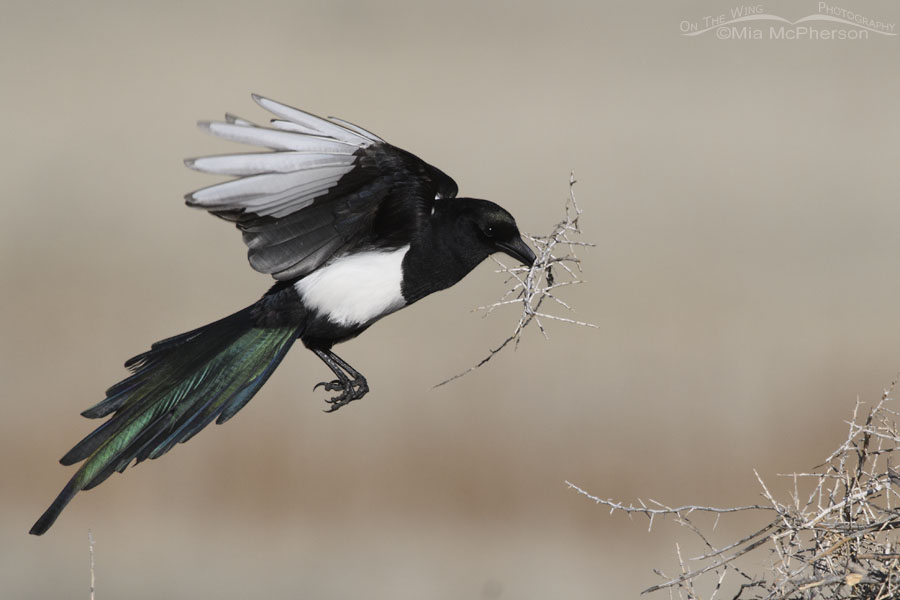It was my first full spring in Utah, nearly 14 years ago, when my keen eyes were used to find my first Black-billed Magpie nest on Antelope Island State Park. That nest lasted for several years.
 Black-billed Magpie in flight with nesting material for its nest – Nikon D500, f7.1, 1/3200, ISO 500, Nikkor 500mm VR with 1.4x TC, natural light
Black-billed Magpie in flight with nesting material for its nest – Nikon D500, f7.1, 1/3200, ISO 500, Nikkor 500mm VR with 1.4x TC, natural light
I took thousands of photographs of these noisy, black-and-white birds as they worked on their nest from one year to the next.
When the light angle was right, I could catch the gorgeous green and blue iridescence of their wing and tail feathers shimmering in the morning light. Sometimes, I could even capture the blue water of the Great Salt Lake in the background.
Year after year, I kept hoping to be at that nest when the young Black-billed Magpies fledged. Every year, I was disappointed.
But I had so much fun photographing the adults that it really wasn’t a big thing. Black-billed Magpies take about 30 to 40 days to rebuild, reinforce, or construct their nests, which meant plenty of time for me to take photos of the adults.
I photographed them on sunny days, dull days, and the morning after snow had fallen on the island. I even froze my fingers. These birds start building their domed nests before winter is even over.
By the time the first nest I found started to collapse in the greasewood from its own weight I had located other Black-billed Magpie nests on the island. It was marvelous fun to photograph all of the magpies no matter where the nests were.
I haven’t photographed Black-billed Magpies at a nest in several years. Oh, how I miss that fun.
Life is good.
Mia
This Black-billed Magpie was photographed at a different nest on the island in March of 2018.
Ethics on photographing nesting birds:
- Do not approach too closely
- If the birds show any sign of distress, back away
- Don’t trim leaves, twigs or branches to get a clearer shot, you may inadvertently attract predators or cause the eggs/chicks to over heat
- Follow local, state and federal guidelines concerning nesting birds
- Don’t harass the birds to get an action shot
- Don’t stay a long time with nesting birds or chicks, that disrupts their normal behavior
- Always remember that your scent may draw predators to the area of nesting birds or birds with chicks.
For more information on the ethics of photographing nesting birds or chicks check out the Principles of Birding Ethics published by the American Birding Association.
Click here to see more of my Black-billed Magpie photos plus facts and information about this species.
Like this:
Like Loading...
Related Posts
 Black-billed Magpie in flight with nesting material for its nest – Nikon D500, f7.1, 1/3200, ISO 500, Nikkor 500mm VR with 1.4x TC, natural light
Black-billed Magpie in flight with nesting material for its nest – Nikon D500, f7.1, 1/3200, ISO 500, Nikkor 500mm VR with 1.4x TC, natural light

Wonderful shot — and even more wonderful ethics.
I have loved yours and Ron’ s photos from the nest. So many changes to things we loved and revered.
Gorgeous flight capture Mia.